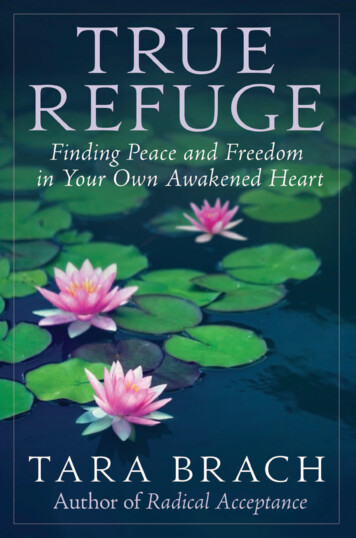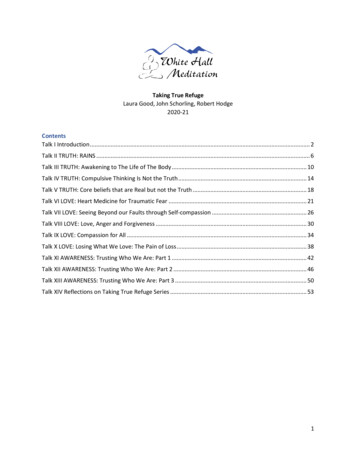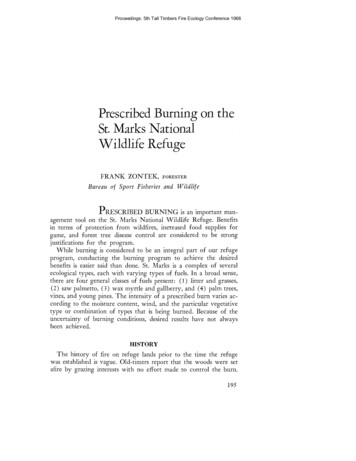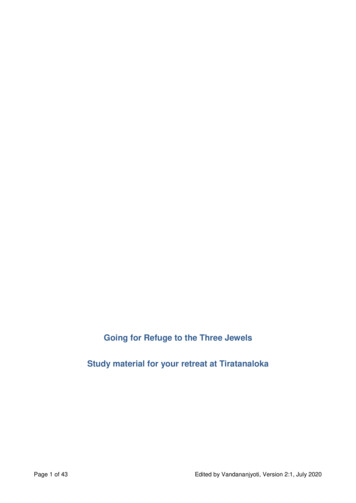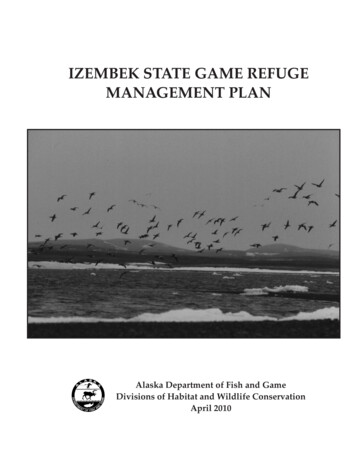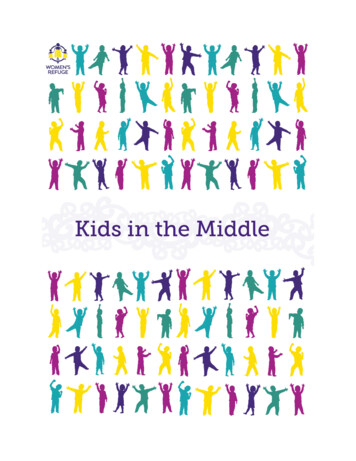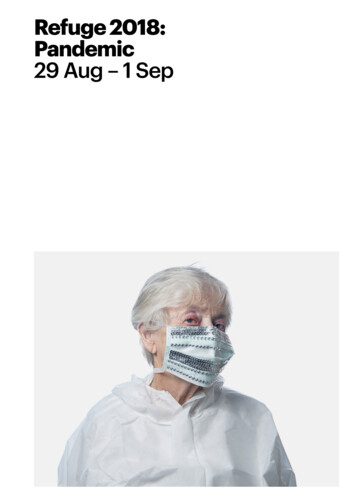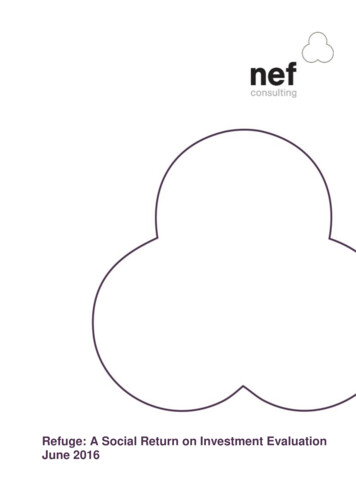
Transcription
Refuge: A Social Return on Investment EvaluationJune 2016
Refuge: A Social Return on Investment EvaluationTitle:Refuge: A Social Return on Investment EvaluationDate:9th June 2016Authors:Aiden Selsick, Emily AtkinsonClient:RefugeCopyedited by: Sarah SuttonDate: 11th July 2016Technically assured by: Emily AtkinsonDate: 9th June 2016NEF Consulting is the consultancy arm of the UK think tank, NewEconomics Foundation (NEF). We put NEF’s ideas into practice byplacing people and the planet at the heart of decision making.New Economics Foundation (NEF) is an independent think and dotank that inspires and demonstrates real economic wellbeing. Wepromote innovative solutions that challenge mainstream thinking onsocial, economic and environmental issues.NEF Consulting LimitedNew Economics Foundation10 Salamanca PlaceLondon SE1 7HBwww.nefconsulting.comTel: 020 7820 6361
Refuge: A Social Return on Investment EvaluationContentsContents . 31. Introduction . 41.1 About Refuge . 41.2 Overview . 42. Methodology . 62.1 Limitations of the data. 63. Theory of Change . 83.1 Introduction. 83.2 What changes?. 84. Results . 114.1 The bottom line . 114.2 Key findings . 114.3 Discussion . 124.4 Breakdown of findings . 13Appendix A: The Refuge services . 19Refuge integrated services and accommodation . 19Outreach services . 19Independent Domestic Violence Advocates (IDVAs) . 19Services for victims of sexual violence. 19Appendix B: Summary of Social Return on Investment (SROI) . 20Appendix C: Glossary of terms . 21Appendix D: Additional notes and calculations . 22The willingness-to-pay discount . 22Means-tested benefits . 23Take-home salary . 23Leisure spending . 24
Refuge: A Social Return on Investment Evaluation1. Introduction1.1 About RefugeRefuge is the UK’s largest single provider of specialist support for survivors of violenceagainst women and girls (VAWG), supporting over 3,800 women1, children and men on anygiven day.2Refuge’s network of services operates nationally across 53 local authority boroughs anddistrict and county councils, and includes more than 40 refuges. Refuge also runsindependent domestic violence advocacy services; culturally-specific services – includingprogrammes for Vietnamese women and Eastern European women ; community outreachprogrammes; and single-point-of-access services – which act as the first point of contact foranybody experiencing gender-based violence across the whole of a local authority area. TheNational Domestic Violence Helpline is run by Refuge in partnership with Women’s Aid andreceives more than 200 calls every day. In addition, Refuge runs award winning pro bonoprevention and awareness raising campaigns.Refuge operates a three-pronged approach to address domestic violence, which includes: Provision: Providing a national network of high quality services that support abusedwomen, children and men in regaining control of their lives and move forward in apositive way.Protection: Advocating for improvements in policy and practice aimed at addressingdomestic violence and other forms of gender-based violence, and theimplementation of legislation to meet the needs of abused women and children.Prevention: Helping to prevent domestic violence through campaigning, education,training and research, and working in partnership with other agencies to raiseawareness of domestic violence, its causes and solutions.The following four Refuge services form the focus of this report:3 Integrated services and emergency housingCommunity outreachIndependent Domestic Violence Advocates (IDVAs)Services for victims of sexual violence41.2 OverviewRefuge appointed NEF Consulting (the consultancy arm of the New Economics Foundationthink tank) to prepare a social valuation of its services for survivors of domestic violence. Aninitial report was produced in 2013 based on engagement with Refuge service users and1Refuge provides services for both men and women who are victims of domestic abuse. However, asmen make up a very small minority of clients this report focuses exclusively on women and theirchildren (of the 3,800 individuals supported each day approximately 1,500 are women, 2,250 arechildren and 50 are See Appendix A for a more detailed explanation of these services.4Note that the outcomes measured in this model are focused on victims of VAWG and do notperfectly represent the impacts of the service for victims of sexual violence (ISVA). For this reason,the social return may appear disproportionately small compared with the other services in this report.
Refuge: A Social Return on Investment Evaluationdata from Refuge’s case management information system, which used an integratedoutcomes framework, known as REMIT. In January 2016, Refuge requested an updatedreport to reflect their enhanced service provision, using the more comprehensive data madepossible by an updated version of REMIT, now renamed IMPACT.5 (See Figure 1)Figure 1: Impact logoThe research in both reports follows a Social Return on Investment (SROI) methodology – aframework that measures the social, environmental and economic value created for bothservice users and wider society. SROI helps organisations to understand and manage theirimpact across all stakeholders, rather than simply focusing on revenue or cost savings forone stakeholder.5IMPACT . 2015. UK0000302942 and UK00003115256, Refuge, UK.
Refuge: A Social Return on Investment Evaluation2. MethodologySocial Return on Investment (SROI) evaluates the return on investment for non-monetaryendeavours by assigning financial proxies to non-financial outcomes. It requires a robustmethodology6 which has been applied as summarised below: Engage stakeholders to identify outcomes: SROI makes no assumptions aboutthe impact of a service, it only measures the outcomes that stakeholders feel areimportant to them. Therefore, a workshop was conducted with Refuge clients in 2013to understand the changes they experienced as a result of accessing support, andhow they feel about them. The results of this engagement, together with input fromRefuge staff and management, informed the development of a Theory of Change(see Figure 2) and the identification of primary outcomes for this study. Evidence outcomes through data: Outcomes are measured for three stakeholdergroups: women, their children, and the state, using appropriate data indicators toshow progress towards, or the achievement of, key outcomes. These outcomes aregrouped into four primary domains aligned with the goals of the organisation: safety,health, social wellbeing, and economic wellbeing. Refuge uses a bespoke electroniccase management information system (IMPACT), which holds anonymisedaggregated data on over 48,000 cases and is capable of generating high-resolutionreports on outcomes, as well as ‘distance travelled’ for each client between intakeand exit.7Data extracts covering the period 1 April, 2015 to 31 March, 2016 provide the basisfor this report. Model and calculate Social Return on Investment (SROI) using contextual data tounderstand the value of the change created by Refuge. This process disentanglesthe net effect of Refuge’s services, deducting the cost of improvements thatstakeholders would have experienced in the absence of Refuge’s intervention. Communicate findings to prove and improve the value of Refuge’s work. In additionto their aggregate impact, this report provides a breakdown of impact for eachstakeholder group, by service type, and according to each measured outcomedomain, to help Refuge analyse their key strengths and weaknesses, as well asidentifying areas where additional data would be useful.2.1 Limitations of the dataCalculating SROI is helpful as a tool for evaluating impact and identifying organisationalstrengths and weaknesses. But like all data-driven approaches, it is an imperfect descriptorof lived experience. It is important to remember that underlying the figures in this report arethe experiences of unique individuals with complex lives.In fact, this SROI is a deliberately conservative estimate of Refuge’s impact on its clients.Several key aspects of domestic violence have been omitted or underplayed, as explainedbelow:67See Appendix B for an introduction to SROI.Further information about IMPACT can be found on the website impactbyrefuge.org.uk
Refuge: A Social Return on Investment Evaluation Stakeholders: Refuge provides services for both men and women who are victims ofdomestic abuse. However, men make up a very small minority of clients and there islimited literature and a lack of robust evidence on this group. For this reason, theiroutcomes are omitted from this evaluation. Homicides: Current statistics estimate that two women per week are murdered byeither a current or former intimate partner, in England and Wales alone. WhileRefuge and its clients feel intuitively that Refuge’s services prevent further homicidesfrom taking place, this is difficult to prove. Therefore homicide prevention is notfactored into this evaluation. Incidents: Many financial proxies used in this SROI are based on estimated costsper domestic violence incident; by all accounts, this is likely to be a grossunderestimate. Research suggests that most victims of domestic violence willexperience 35 incidents of abuse before they seek help, but police statistics caprecorded incidents at five, making it impossible to assess the true extent and cost ofthe crime.
Refuge: A Social Return on Investment Evaluation3. Theory of Change3.1 IntroductionA Theory of Change describes the process through which change occurs, with thoseinvolved in benefitting from a service being actively involved in ‘telling the story’ of how theservice affected them. To develop this story, we held a workshop with Refuge service usersto discuss their experiences.The outcomes described below are grouped by Refuge’s impact domains, as recorded viaIMPACT, and reflect the outcomes that service users identified as being most important tothem – safety, health, social well-being and economic well-being. There is a high degree ofoverlap and interaction between outcomes, and it was made clear that the path fromdomestic violence to independence is a complex one.Figure 2: Theory of Change3.2 What changes?3.2.1 SafetyThe most immediate concern for most women who come to Refuge is their physical safetyand the safety of their children. While fear of physical harm is often the most compellingreason for women to flee their homes, service users reported that many perpetrators also
Refuge: A Social Return on Investment Evaluationinstil further fear in their victims by isolating them and threatening that their children will betaken away. Perpetrators of violence towards black, minority ethnic and refugee womenthreaten that the women will be shunned by their communities or will be deported. These areequally powerful modes of control and domination.Safety is a basic requirement of survival, but of equal importance from the perspective ofwomen and children, is the perception of being safe. Feeling safe generates many benefitsin other domains, including: better sleep and associated health improvements; a reducedrisk of mental health problems, substance misuse, and self-harm; improved optimism andautonomy; greater ability to undertake daily tasks; and fuller participation in society.Refuge activities and services that contribute to safety and perceptions of safety include: the development and implementation of individual support and safety planshelp finding new safe accommodationsupport where appropriate to report domestic violence to the police and to seek legalprotection3.2.2 HealthDomestic violence impacts negatively on health in a number of ways beyond immediatephysical harm. Anxiety and depression are mental health conditions commonly experiencedby women and children who have been subjected to abuse. In addition, violence towardswomen during pregnancy (during which time 30% of abuse begins or intensifies) commonlyresults in complications, potentially harming the child before it is even born.Protecting women from violence reduces physical harm and injury; additionally, women whoescape the emotional abuse of domestic violence are less vulnerable to developingassociated mental health issues.Women are often disempowered to care for their children, through imprisonment in thehome, due to financial control by a partner, and through isolation from systems of care andsupport. A sense of shame is cited as one reason why some women may not seek medicalhelp for themselves or their children. The State, with its responsibility for providing medicalcare (to those who suffer from poor mental health) and support (through benefits) for thosewith poor physical health, has the potential to benefit from a reduction in incidents ofdomestic abuse.Refuge activities and services that contribute towards health benefits include: support with immediate urgent health needsthe opportunity for women to discuss the emotional effects of domestic violence onthemselves and their childrenthe provision of information about community-based specialist services3.2.3 Social wellbeingIsolation is a universal theme of domestic violence, common to the experience of all serviceusers. Perpetrators deliberately isolate their victims in order to facilitate their own behaviourand escape punishment. The shame that many victims feel means that their isolation iscompounded as a result. Women report feeling isolated from other members of their family,who may not understand the gravity of their situation, and who in some cases may activelyshun the victim of abuse.
Refuge: A Social Return on Investment EvaluationSocial isolation is distressing, and also has practical impacts. Isolated women and childrenare unable to access information, advice or support, cannot build trust in other people orcommunity services, have no ability to build a support network and experience many barriersto securing successful employment and education.By escaping a violent partner, and overcoming the stigmatisation that many women andchildren feel as victims, space is created for friendships to grow or become re-established.Through Refuge services, many women forge a strong connection with others who havebeen victims, where mutual understanding of a shared experience is quickly apparent. Foryoung people, school attendance and participation are likely to improve if abuse ends.Refuge activities and services that contribute to social well-being include: support in reconnecting with supportive friends and familyprovision of information about social activities for women and their children3.2.4 Economic wellbeingFinancial abuse is a common feature of domestic violence. Limiting access to funds,monitoring expenditure, as well as reducing the woman’s ability to make financial decisionsprovides the perpetrator with a high degree of control over all aspects of her life. Women inthis situation often have no understanding of how to manage their finances, what sources offunds might be available to them, or what it costs to maintain a certain standard of living.This makes them fearful of living independently and binds them to the perpetrator.Helping women into financial independence allows them to better care for themselves andtheir families, which can be a prerequisite for giving women the confidence to escape abuse.Often this may be achieved through advising women on their entitlements to benefits orsupport services. Ultimately, returning to work increases self-esteem and extends socialnetworks, which then has positive effects on other aspects of women’s lives.From the State’s perspective, the ability of women to achieve financial independence and tosupport their families, can mean increased tax revenue from earnings as well as a reductionin benefits payments – though in the short term expenditure may rise as women take upentitlements.Refuge activities and services that contribute to economic empowerment, include supportwith: reviewing survivors’ financial situationobtaining, clarifying and changing financial documentationassistance in claiming benefits for women and their childrensupport to obtain new employment
Refuge: A Social Return on Investment Evaluation4. Results4.1 The bottom lineThe Social Return on Investment (SROI) for Refuge is calculated to be 4.94:1. This meansthat for every 1 invested, clients, their families and society-at-large reap a rewardequivalent to 4.94.4.2 Key findingsKey findings from this SROI analysis highlight:8 The extraordinary value of Refuge’s services: Through its four service streams:refuge housing, community outreach services, independent domestic violenceadvocacy services, and sexual violence services, Refuge generates an average of 4.94 in social value for every 1 invested. For some services this ratio is evenhigher: Outreach services generate 6.92 and IDVAs generate 7.14. The impact of refuge housing: Although carrying high unit costs, refuge housinghas the greatest impact of all Refuge’s services. While only 21% of Refuge clientsuse the housing service, it accounts for 54% of the total social return in this study.The SROI ratio for refuge housing is also an impressive 4.07 for every 1invested. The burden of VAWG on society: A stark finding of this study is the overall burdenof intimate partner violence, not only on the victims and their families, but on societyat large. Counting only those families who used Refuge’s services in the year2015/16, savings of 1.7 million of public funds were made in the criminal justicesystem, and 4.2 million were made in healthcare costs. Whereas, during the sameperiod gains of 3 million were made, through economic productivity and reducedbenefit payments8. These savings are indicative of the heavy costs associated withabusive crimes. Distribution of benefits: Of the three stakeholders groups, women, their children,and the State, women capture the largest share of benefits at 63%. Childrencapture 30% of the value and the State receives 7%. As mentioned above, refugehousing accounts for 54% of the impact experienced by Refuge’s clients, withIDVAs contributing 39%. Outreach services claim the remaining 7%. Sexualviolence services do not feature in this comparison owing to the current scale of theservice. The distribution of benefits by outcome domain is unequivocal: safety takesa full 71% of the SROI; health and economic wellbeing take 13% and 14%respectively; with social wellbeing accounting for the remaining 2%. Though small,this social wellbeing percentage should not be trivialised, as former Refuge clients’emphasised vehemently that social wellbeing was central to their ongoing quality oflife.It is estimated that one million women in the UK experience some form of domestic abuse duringany given year. Source: HM Government (2015), A call to end violence against women and girls:Progress report 2010-2015, Policy paper, 8 March 2015. Crown copyright.
Refuge: A Social Return on Investment Evaluation4.3 DiscussionThe SROI methodology attempts to translate social outcomes into financial returns, whichnecessitates a leap in deductive reasoning. For this reason, it is especially important toensure that every step of the process is documented, each decision is based on wellfounded research, and that the most conservative estimates are used in order to avoidinflation of results. Below is a summary of the measures taken to ensure that the findings inthis report are as representative as possible. Attribution: The majority of women receive help from more than one source.Refuge refers most of its clients to multiple services for social or medical support, toensure that their specific needs are met. While help from friends or family may notbe forthcoming at first, Refuge also helps women to think about who might be ableto offer assistance and, where possible, could support them in connecting to othercommunity opportunities. As such, ‘Attribution’ accounts for the proportion of goodoutcomes that should be credited to these other factors of support. Cherry picking: Naturally, some results are more flattering than others. This reporttakes care to represent the benefits as well as the financial implications of Refuge’swork. Specifically, full attention is given to the costs borne by the welfare system insupporting women who require financial help as a result of fleeing the family home. Conservative estimates: Where there is a range of possible options in any of theSROI domains, the most conservative estimate has been chosen. For example, thevalue of family relationships was given a proxy equivalent to the recreationalspending of a family with only one adult and one child, in the lowest income decile. Deadweight: This acknowledges the possibility that some people who escape fromabusive relationships might do so without ever contacting Refuge. While evidenceon this counterfactual outcome is understandably elusive, research suggests, forexample, that a small proportion (about 14%) of perpetrators will spontaneouslycease their abuse without any intervention. As such, 14% of overall impact hasbeen discounted for the relevant outcomes. Displacement: This SROI values the impact of services provided by Refuge notonly on its clients, but also on the broader societal scale. For this reason it isnecessary to assess whether a good outcome for a Refuge service user might, as aconsequence, prevent a positive outcome for another victim of domestic violence.For most outcomes, this is not the case – one person’s improvement in confidencedoes nothing to stifle another’s. However, in some situations, such as needingrefuge housing, limited availability does mean that one family’s gain will beanother’s loss. This is accounted for in the calculations. Double counting: Some of the outcomes assessed in this SROI are overlapping. Akey example is the financial proxy used to quantify personal safety: people wereasked what they would be willing to pay to avoid serious injury. It may be assumedthat their calculus included anxiety about lost income from work, long-term healthconsequences or disability, isolation from friends and family, depression etc. This
Refuge: A Social Return on Investment Evaluationfinancial proxy was therefore diminished significantly, to ensure that the health,social and economic components of the safety domain were not being accountedfor multiple times. Drop-off: While positive changes supported by Refuge’s work may endure long intothe future, other factors may also play an increasing role as time goes by. Forexample, a woman’s safety in the first year may be completely dependent on arefuge service, but as she reintegrates into her community and builds resiliencethrough work, study, and personal care, these latter components will deservegreater credit for sustaining this outcome. The model therefore discounts the impactof Refuge over time. Net Present Value: The impact of Refuge’s work lasts beyond the timeframe of theactual intervention, and is valued in this model over a period of three years. In orderto prevent inflation from skewing the calculations, the final numbers are reduced toa net present value, determined at the current rate of inflation. The Consumer PriceIndex (CPI) is used as the relevant inflation rate, as it most closely represents theaverage spending, per person, on common household goods. The CPI currentlystands at 0.3% and is not likely to show significant movement over the mediumterm.9 Sensitivity testing: Translating human experience into data will inevitably requiresome decisions or assumptions to be made – about how to account forcounterfactual outcomes, for example. It is therefore important to run alternatescenarios to check that these decisions do not unduly affect the outcome of themodel.4.4 Breakdown of findingsThe following section provides a high-level overview of the findings of the SROI evaluation.Table 1 provides some key facts and figures used in the calculations. Tables 2, 3, and 4show Refuge’s impact – by stakeholder group, outcome domain and service type. Tables 5,6 and 7 explain the indicators and financial proxies used in the model. A summary of thestages and principles of SROI is provided in Table 8.Additional notes and calculations can be found in Appendix D.9Retrieved from the office of National Statistics’ (ONS) latest release of the Consumer Price InflationStatistical viousReleases
Refuge: A Social Return on Investment EvaluationTable 1: Key facts and figuresService typeRefugeTotalOutreachIDVAsSexualviolenceNumber of women included in this study5652991,707652,636Number of children included in this study7074102,665393,821 5,608,377 458,200 2,306,041 268,458 8,641,076 4,409 646 527 2,581Investment in services ( p.a.)Unit costs of services ( p.a.)Table 2: Social return on investment for womenOutcome domainNet value generated by service type ( )RefugeOutreachIDVAsAggregate net value ( )SexualviolenceSafety 8,374,784 48,479 205,579 7,446 8,636,288Health 887,671 63,299 144,959 11,517 1,107,446Social wellbeing 331,086 55,131 215,858 4,948 607,023 7,024,948 510,002 1,509,194 18,178 9,062,321Economic wellbeing
Refuge: A Social Return on Investment EvaluationTable 3: Social return on investment for childrenOutcome domainNet value generated by service type ( )RefugeOutreachIDVAsAggregate net value ( )SexualviolenceSafety 8,374,784 48,479 205,579 7,446 8,636,288Health 253,041 170,150 737,058 48,704 1,208953 35,861 435,611 2,430,617 13,628 2,915,717Social wellbeingTable 4: Social return on investment for the StateOutcome domainNet value generated by service type ( )RefugeOutreachIDVAsAggregate net value ( )SexualviolenceSafety 777,153 168,836 733,283 48,478 1,727,750Health 1,358,925 435,611 2,430,617 13,628 4,238,781( 2,778,249)( 84,489)( 140,524)( 4,023)( 3,007,285)Economic wellbeing
Refuge: A Social Return on Investment EvaluationTable 5: Indicators and proxies – WomenThe table below shows the assessed value for each measured outcome for the women who use Refuge services.Outcome domainOutcomeIndicatorProxy descriptionSafetyBeing safeFreedom from violence (classed asserious according to severity, durationand/or frequency of incidents)Willingness to pay to avoid serious injury(discounted to avoid double counting)Freedom from violence (classed asmoderate/mild according to severity,duration and/or frequency of incidents)Willingness to pay to avoid moderate injury(discounted to avoid double counting)Feeling safeFreedom from threatening andcontrolling behavioursWillingness to pay to avoid mild injury(discounted to avoid double counting)Improved physicalhealthEnabled to seek appropriate medicalcareValue of moving from moderate pain to nopain, equivalent to 20.4% of a 30,000quality-adjusted life year (QALY) 6,120Improved mentalhealthImprovement in psychologicalassessment scoreValue of moving from severe mental illnessto mild/no mental illness, equivalent to35.2% of a 30,000 quality-adjusted lifeyear (QALY) 10,560Value of moving from moderate mentalillness to mild/no mental illness, equivalentto 9.8% of a 30,000 quality-adjusted lifeyear (QALY) 2,940HealthSocial wellbeingEconomicwellbeingProxy value 29,699 2,175 68Improved socialconnectionsImproved family relationshipsHalf of family culture and
Refuge is the UK's largest single provider of specialist support for survivors of violence against women and girls (VAWG), supporting over 3,800 women1, children and men on any given day.2 Refuge's network of services operates nationally across 53 local authority boroughs and district and county councils, and includes more than 40 refuges.
